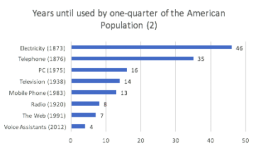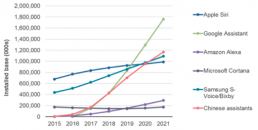Predicting the future is hard work, and as we come to the close of the 21st century’s second decade, it is fair to say that the science-fiction writers of the 20th century did a so-so job of predicting the technological future. Despite much complaining on Twitter, we have neither flying cars or hoverboards. And though we are sure that Jeff Bezos, Elon Musk and Richard Branson are doing their level best, commercial space travel seems a few decades away from being a genuinely accessible reality.
The rapid rise of artificial intelligence (AI)-powered voice-based assistants have been the exception to that rule. An AI assistant wasn’t necessarily unheard of 10 years ago — but for the average customer, it fell into the realm of fantastical technologies that they were most likely to encounter as a plot device in a summer blockbuster. Perhaps helpful if one’s superhero team is defending the Earth against imminent destruction, but not necessarily the sort of thing most consumers saw themselves ordering their groceries on someday.
Voice-activated AI hasn’t just made the leap from science-fiction offering to real-world product in the last decade — it has gone mainstream quickly. Remarkably quick as a matter of fact.

It took electricity 50 years to reach one quarter of the American population; the telephone took 35 years. The mobile phone, television and personal computer took 13, 14 and 15 years, respectively, to hit the 25 percent mark. Voice assistants, on the other hand, have taken four years — starting in 2012, the year Siri was first rolled out to the public.
According to all estimates, we are still in the earliest days of consumers forging connections with artificial intelligence. Forecasts from comScore estimate that $1.2 trillion searches will be done by voice by the year 2020, about 50 percent of all searches. By the year 2022, voicebot.ai predicts that $40 billion in commerce activity will be done via voice. According to MIT Technology Review, the number of households with smart speakers have roughly doubled over the last year and are expected to increase by 25 percent within the next two years.
Advertisement: Scroll to Continue
As devices and digital touch-points are proliferating, consumers are increasingly interested in interacting with voice AI in a wider variety of contexts.
Among those polled for NPR’s Smart Audio Report, 30 percent of consumers reported interest in pursuing smart technology for their home, with 16 percent noting they are highly interested. That enthusiasm jumped up when asked about cars: 64 percent of polled consumers expressed interest, with 39 percent being very interested.
It’s a big market today (which will be an exponentially bigger market tomorrow), one that innovators from all over technology, retail, payments and financial services are rushing to get in on at the ground floor, even though that ground floor itself is being built underneath them.
So, where to look to understand what’s next?
The Who, Where And How Of Voice Assistants
While most people tend to jump to smart speakers — or perhaps smart appliances — when they think about interacting with an AI voice assistant, as of today, the device consumers are still most likely to use for voice AI is their mobile phone. Thirty-seven percent of consumers who have interacted with a voice AI have done so via a phone, whereas only 27 percent have used a smart speaker. That makes smart speakers the fourth most likely access point, trailing laptops, tablets and desktop computers, but still edging out wearables and AI in cars.

This means firms with mobile phone ecosystems of their own — namely Google, Apple, Samsung and various Chinese manufacturers — still have the advantage when it comes to the installed base numbers (see chart to the right) and getting their AI products out in front of consumers.
Amazon Alexa’s biggest users, demographically speaking, are young, but not the youngest-possible consumers. When tracked, those youngest customers — ages 18 to 24— are arguably the lightest users of voice assistants at present. Though they had the second-highest count of “heavy users” (59 percent), according to a Pew Research Center report, they had fewer moderate users than the oldest consumer group — ages 50 and older. The youngest consumer group also had the largest share of self-described light users at 8 percent, compared to the older consumers at 3 percent and the “middle-aged” consumers (ages 25 to 49) at 6 percent. The young(ish) consumers — ages 25 to 45 — had the highest heavy-use rate, clocking in at a full 65 percent.
As for what consumers are doing with the help of their smart-AI assistants? Currently, people are most likely to ask questions and get them answered, followed by using their voice AI to help them stream music. When asked why they like using voice AI, consumers most commonly answer that a voice assistant makes it easier, more convenient and faster to search for something online. They also tend to rate the experience more highly than talking to a human being or having a text-based conversation.

As a not-so-shocking corollary, given consumers’ preferred uses today, the issues most likely to leave smart-AI customers dissatisfied is difficulty in understanding natural human speech and answers that are inaccurate or not appropriate to the question they’ve been asked.
However, Amazon Pay’s VP and GM Patrick Gauthier told Karen Webster, in a late December 2017 conversation, that the potential for smart speakers and voice is so much more than just another tool that consumers can use to search or connect to media content. It is about reaching into the interactions of consumers’ day-to-day lives and finding ways to remove the frictions.
“If we try to reproduce with voice what has been working with mobile, it will be a lost opportunity,” Gauthier said. “I am absolutely positive that the introduction of voice as an interface, and the frictionless embedding of payments, will open up new commerce use cases. There’s no limit to the type of conversations that humans can have.”
Pushing Commerce Frontiers
When PYMNTS and Visa surveyed consumers about the connected commerce future for the “How We Will Pay” study, two facts became apparent. The first was that connected commerce has not quite begun yet. While voice assistants are making big inroads with consumers, using them to transact is still in its most nascent phases — only about 1 percent of consumers reported having used them to shop.
The second thing that became apparent was that consumers are ready, willing and able to be offered something better. As Karen Webster noted in her commentary on the research, customers aren’t necessarily looking for a more fun-filled shopping experience, but something a good deal less friction-filled.
Today’s time-starved consumers told us that shopping is anything but relaxing, fun and productive. More than 60 percent, in fact, described it as unproductive, inefficient, time-consuming and even boring. That’s irrespective of where they shop — online or at a physical store. What consumers want, according to their own feedback, is a total commerce experience, where shopping and paying comprise a single, seamless and fluid experience — and 83 percent said they would be willing to use a connected device to make it happen.

What that connected device is in consumers’ minds, however, is up for interpretation. Today, they are mostly thinking about smartphones — 38 percent told PYMNTS that it was the most valuable device for improving the shopping experience, while only 2 percent said voice-controlled assistant.
That is, perhaps, owing to change — as the number of customers leveraging voice assistants, particularly through smart speakers, is on the rise — and experts are predicting an attendant bump in connected commerce. Voice commerce sales in 2017 were 1.8 billion in the U.S. By 2022, they are forecast to clock in at around 40 billion. That growth, according to data from PricewaterhouseCoopers (PwC), owes to voice’s increasing popularity among users as a commerce method.
PwC found that 36 percent of consumers would rather use a voice assistant to shop than go to a physical store, 35 percent said they would rather shop through voice than through a mobile app, and 24 percent said they prefer using a voice assistant to shopping online.
A quick glance at PYMNTS Bridge Millennials data bears out the same trend. Among older millennials entering their prime spending years, voice is an increasingly popular tool in an increasing number of categories. At 4.8 percent, Bridge Millennials report using a voice assistant when making purchases of clothing and/or deciding what to buy and where to buy it — twice as much as other groups.
Moreover, Karen Webster noted, Bridge Millennials play ideally into the coming voice-commerce revolution because they value convenience above all things in commerce. Convenience is what drives the shopping decisions for Bridge Millennial, followed by having the product they want to buy. Rewards and loyalty schemes are way down on the list.
Commerce via voice assistant is clearly on an upswing. As of 2016, only about 1 percent of consumers had transacted via voice devices. By 2017, that figure had grown to 3 percent, and is projected to expand to 18 percent by the end of this year on some forecasts. Today, consumers are most likely to purchase grocery and household items, electronics and beauty supplies — with over 20 percent of consumers reportedly being interested in using voice-activated assistants for travel reservations, clothes shopping, transportation or booking reservations in the future.
The key — according to Brian Abele, director of Segment Solution Strategy at Fiserv, earlier this year when discussing the Alexa Voice Challenge — is that customers have shown a clear desire and willingness to add more payments and financial services functionality. The challenge now is building up the trust in these system’s security requisites to push increased adoption.
“We see that in financial services, and we see it all over the place. Consumers want to be able to pay a bill, wherever they are with whatever they have … including an Echo that’s sitting up there on the [shelf] corner,” he said. This is now about building “the right security controls around information” and giving customers “the foundation for having trust built up into that conversational experience” so that “later on [the consumer may say], ‘I’m getting value from this stuff. I want to go to the next step up.’”
Preparing to catch those customers as they get ready to level up? At this point, to main competitors — with a lot of dark horses in the distance.
The Smart-Speaker Race
The U.S is the world’s largest smart-speaker market by a fairly wide margin with 46 percent of all smart speaker sales — China represents about 26 percent of the market, Korea with 8 percent and the rest of the world measuring at around 20 percent. In that market today, Amazon is the ranking champion, accounting for 62 percent of the market. Google is far behind, with 27 percent of the share.
The numbers, Karen Webster noted, really only tell part of that story because Alexa not only has the bigger breadth of reach among smart-speaker consumers, but a fair amount of depth into the customers it serves. Alexa users are fairly entrenched and loyal.
Amazon has a pervasive voice assistant — Alexa — that started on Amazon-branded devices, but has quickly moved into lots of others too, including cars, appliances and smart-home devices. Today, Alexa is also a mobile app on smartphones and wearables, and is much more than an AI bot. People speak about Alexa as if she’s a member of their family.
Don’t know what to have for dinner tonight? Ask Alexa. Don’t know what kind of new car to buy? Ask Alexa. Don’t know how badly your NCAA brackets have been busted? Ask Alexa. Need a joke to take your mind off how badly your brackets are busted? Ask Alexa. Alexa, in other words, is fast becoming part of the consumer’s day-to-day life.
Google, though, has started to make inroads of its own — and an increasing number of market watchers are noting that Google’s background in search may provide an edge for it in building the broadly smarter AI-based personal assistant.
“The biggest strength of Alexa, of Amazon, is right now the market penetration, and their goal of getting Alexa into everything and everywhere,” noted Chris Neff, senior director of innovation at The Community advertising agency. He went on to note that when a consumer is looking to transact, Amazon is in its own league.
When it comes time for more generalized voice-AI services (when it comes time for the machine to actually be a virtual assistant), Google tends to do better. But Amazon is leading the field — and with Echo products comprising 1.7 percent of all items sold on Prime Day (up from about 0.1 percent last year), it’s fair to say Amazon was likely boosted in that lead.

Amazon has built a fairly unique ecosystem — one that is particularly desirable to developers. It has grown from a handful of skills when Echo/Alexa launched in 2014 to more than 5,000 in the following year, 10,000 skills less than a year after that, 25,000 skills as of December 2017, to now, with the count past 30,000.
That army of developers is thinking beyond just the smart speaker — and instead thinking about how to embed Alexa into banking apps, security cameras, cars, wearables and anywhere else developers want to take her. Amazon does not have the installed base that it could if it had a mobile phone of its own, but it has laid the foundation for a voice ecosystem that it, for all intents and purposes, owns and can leverage.
“More developers are coming into the Alexa ecosystem because they’ve made it easier for developers to create skills and apps,” said Dan Calladine, head of media futures for the media and marketing agency Dentsu Aegis. “What we are starting to see is more creativity in the space.”
Amazon has another big advantage in the arena: trust. In study after study, the same result shows up — Amazon’s self-reported obsession with the consumer experience has won consumers trust. The Amazon stamp of approval, and the guarantee of security and quality, are commerce beacons that consumers increasingly steer by. That matters as consumers are moving to embrace an entirely new commerce experience and ecosystem.
But the day, of course, is young — and Google is bent on offering consumers an array of trustworthy choices. And though Samsung and Apple are both down in this race, a look at those installed base figures is a swift reminder that they are far from out of the game.
There will likely be many more reports when we check back in for our end-of-the-year Voice Report.

